4 1492 BCE: A New World of Pre-Columbian Painting
Reinaldo Morales, Jr.
https://doi.org/10.52713/ULQY5064
I. Nordeste Rock Art: Archaeology and Style
Geographically, Brazil is most closely associated with the Amazon River Basin in popular discourse, and the vast eastern section of the country, known as the “Nordeste” and comprised of mostly semi-arid, mountainous environments interlaced with deep canyons and rock shelters (Map 4.1), receives considerably less attention from the international community. Yet the Nordeste region includes one of the oldest and most sophisticated prehistoric painted rock art traditions in the New World (Figure 4.1). Unlike other more famous, well studied areas of prehistoric rock art traditions worldwide (aka the Paleolithic cave paintings of Western Europe, the painted rock shelters and canyon walls of Australia or those of the American Southwest and Mexico), the Nordeste rock art styles have only been extensively documented and reported on since the late 20th century, primarily as the result of the Franco-Brazilian Archaeological Mission begun in the state of Piauí, Brazil in the 1970s.1 This essay presents an updated and revised chronology of the Nordeste rock art tradition and its sub-styles, based on more recent dating techniques, and considers the implications of this new chronology for interpretations of two fundamental areas of investigation: the methodological relationship between evolutionary changes in art “styles” across time as compared to archaeologically defined chronologies, and the role of “style” as an index of cultural identity in archaeological contexts.
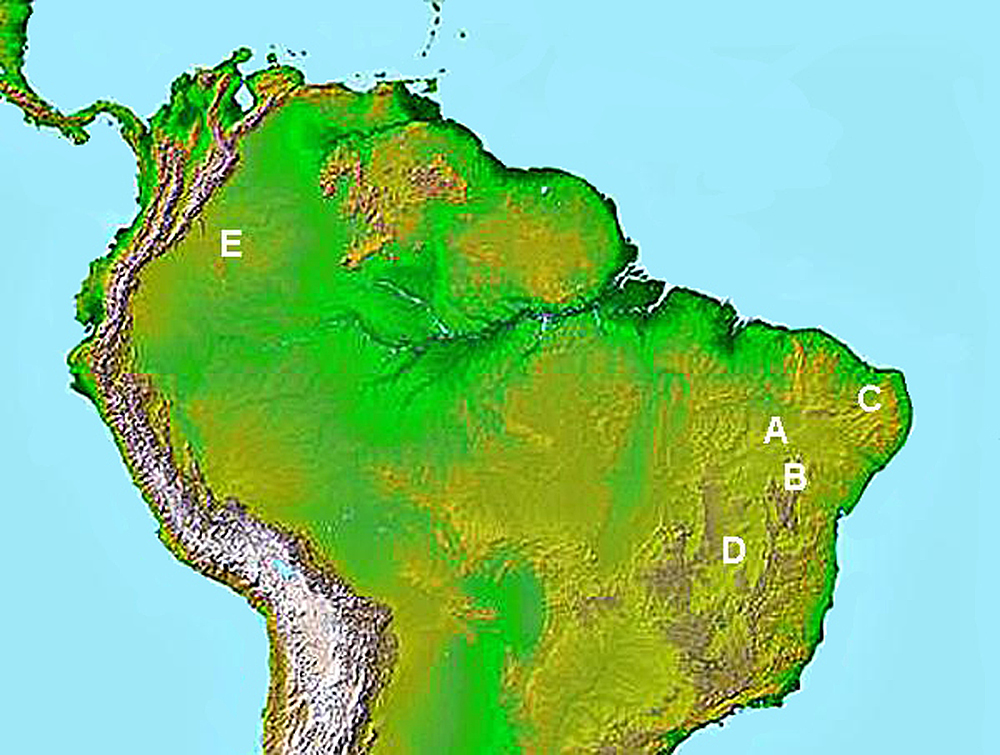
A – Serra da Capivara National Park, Piauí, Brazil
B – Northern Chapada Diamantina, Bahia, Brazil
C – Serridó region, Rio Grande do Norte, Brazil
D – Peruaçu Caverns National Park, Minas Gerais, Brazil
E – Serranía de Chiribiquete National Natural Park, Caquetá and Guaviare, Colombia.
Adapted from NASA Jet Propulsion Laboratory website.

Photo credit Diego Rego Monteiro, Wikimedia Commons, 2011.
Nordeste paintings are evidence of ancient spheres of regional interaction spanning hundreds of square miles of the Nordeste region. The prehistory of the region is one of long periods of cultural continuity punctuated with periods of dramatic innovation, reflecting a pattern that art historian Terence Grieder recognized across most of ancient Pre-Columbian America (Grieder 1982). The Nordeste tradition encompasses diversity of styles reflecting a mosaic of prehistoric cultural expressions. These expressions are part of a ten-thousand year practice of rock painting that spanned periods of ecological upheaval and adaptation. The year 1492 BCE is used here as a rhetorical device to focus our attention on a significant period of innovation in the Americas that gave rise to new worlds of culture, which, in turn, saw the rise of new Pre-Columbian “artworlds”, the term coined by Arthur Danto in 1964, referring to “an atmosphere of artistic theory, [and] a knowledge of the history of art” which surrounds the perception and function of works of art in given societies (Danto 1964; Morales, Jr. and Risatti 2019).
Style as a synchronic unit has been a fundamental assumption of the art-historical concept of period style, and the archaeological notion of chrono-stylistic evolution. Style and iconographic analysis have been the wheelhouse of the art historian, and in the field of rock art research they have proven to be valuable tools. Close analysis style, for example, can identify the work of a single painter in different works. It often allows one to recognize shared values, aesthetics, and associated iconography shared across vast distances. But in the case of Nordeste rock art, the critical limits between assessments based on reasonable diffusion of cultural traits vs. the mere coincidence of generally similar features of in form, are particularly stark. In the Nordeste tradition, we have a historical laboratory of sorts, a collection of images that apparently span almost the entirety of the current, post-glacial period of human activity in the hemisphere (aka the Holocene era), from c.11500 years ago to the present time. This appears to confirm Grieder’s hypothesis that the waves of artistic innovation and continuity reflect the work of “cousins in culture” spanning great distances in both time and space (Grieder 1982:184, 195). Some of the most fundamental questions about this process—this relationship between art, culture, and time—have been posed in the arena of style, and how it operates as a cultural and temporal marker.
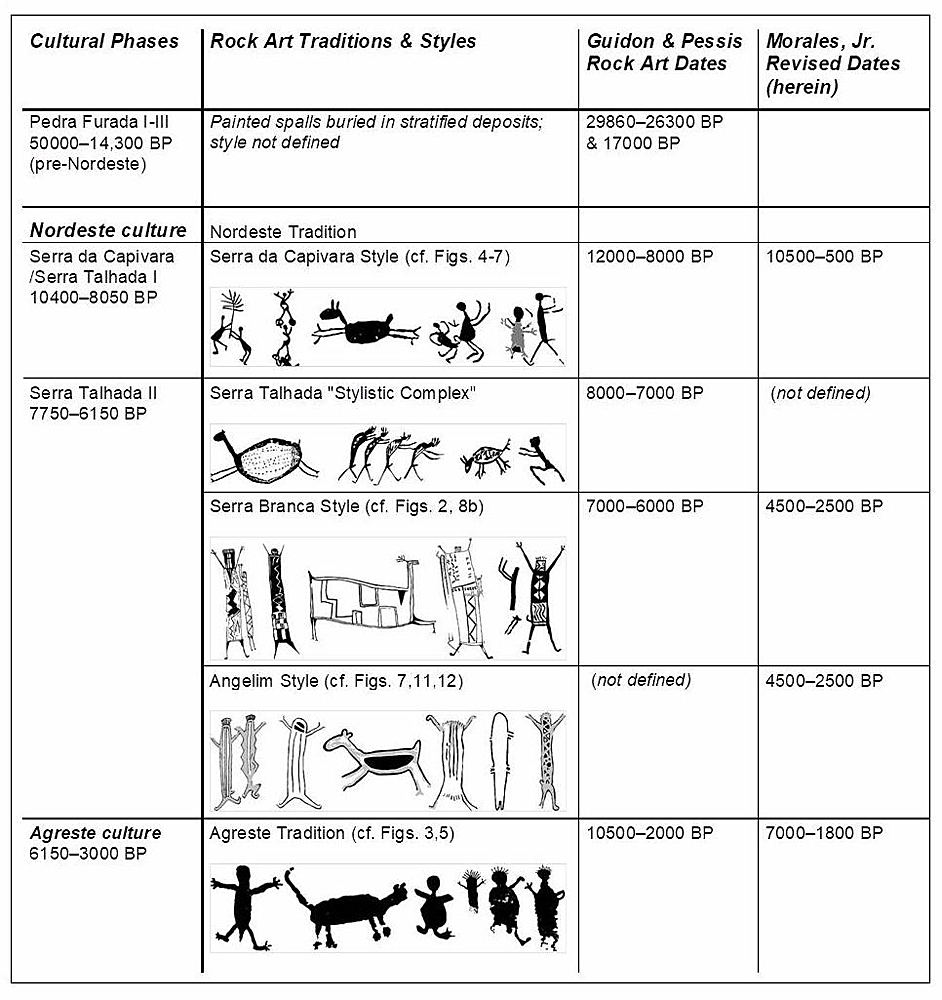
Drawings by Reinaldo Morales, Jr., 2021.
The Nordeste Styles
In the last quarter of the twentieth century, pioneering research by Niède Guidon and Anne-Marie Pessis began reporting on one of the most important concentrations of rock art in the Americas (Guidon 1984, 1986; Pessis and Guidon 1992). By the turn of the twenty-first century, the World Heritage art at Serra da Capivara National Park (UNESCO 2021) had garnered international recognition. It also became the focus of one of the most fundamental debates in archaeology: the antiquity of the earliest migrations of people into the Americas. Archaeological evidence from Serra da Capivara challenged the dominant “Clovis First” paradigm in American archaeology—that the Clovis culture marked the earliest human presence in the Americas, about 13000 years ago. (Lourdeau 2019). The intersection of a new New World chronology and a rich corpus of rock art documented at Serra da Capivara provided new evidence of the antiquity and sophistication of ancient American painting. The site of Pedra Furada provided the model for a proposed cultural sequence based on the evolution of the lithic technology, summarized below and illustrated in Table 1:
- Pedra Furada Phase I: 50000–35000 BP (Before Present)
- Pedra Furada Phase II: 32160–25000 BP
- Pedra Furada Phase III: 21400–14300 BP
- Serra Talhada Phase I: 10400–8050 BP (originally the Serra da Capivara phase)
- Serra Talhada Phase II: 7750–6150 BP
- Agreste Phase: 6150-2000 BP
The rock art at Pedra Furada was associated with the two more recent lithic phases, Serra Talhada I and II: the Nordeste Tradition (c.12000-6000 BP) and the Agreste tradition (c.6000-2000 BP). The Agreste Phase was presumed to end 2000 BP, after ceramics appear across the region (Pessis 1999: 72).
Guidon and Pessis then proposed a rock art chronology that sought to match phases in the lithic evolution with differences in the subject matter of the rock art: “the study of the rock paintings confirms the evolution demonstrated by the study of the lithic industries.” (Pessis 1999: 47; Pessis 1987). This provided the rock art chrono-styles addressed herein. However, more recent test results and newer data, discussed below, now suggest that the Serra da Capivara style persisted until at least 2700 BP, and the Agreste tradition continued until at least around 1800 BP. This data, based on more recent rock art dating techniques, invites a rethinking of Guidon’s and Pessis’ original evolutionary sequence, as well as reconsideration of their original concept of how rock art styles are defined and how they function in their original cultural contexts.2
Chrono-Styles and Evolution
The Nordeste tradition paintings were originally ordered into a series of chrono-styles—an evolution of painting styles superimposed upon the phases of lithic technology evolution. Style, as it was used in this model, was based on themes (iconography) that were interpreted in the paintings, or “moments of chronological evolution of graphic presentation patterns” (Pessis 1992: 35). Iconography is not style, however. Specific formal qualities define the manner in which images are made (the style), not subject matter. Nonetheless, imagery like the “effusive staging of joy and playfulness” (Pessis 1999: 69, author translation) was believed to characterize the earliest style. The lithic material of the original Serra da Capivara phase was thereby connected to the style of the same name, the Serra da Capivara style (Table 4.1). Guidon and Pessis rounded the dates of this style to 12000–9000 BP, consistent with Serra da Capivara style paintings on spalls found in stratified deposits dating between 10040 and 8760 BP.3 Subsequent archaeological investigations at the site of Baixão da Perna confirmed evidence of a reasonable minimum age of 9650–10530 BP for Serra da Capivara style rock art—the cusp of the Pleistocene/Holocene transition.4
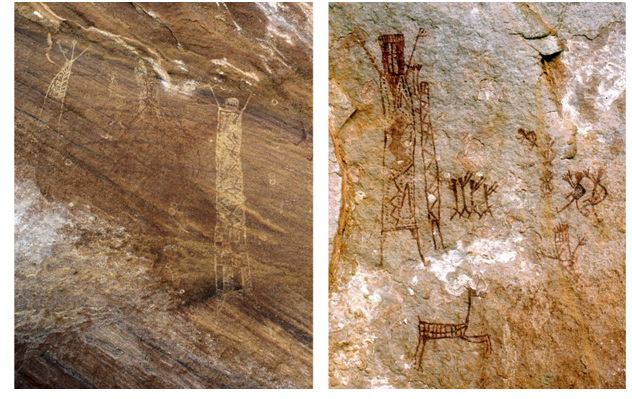
Left: Caboclo (large figure 70 cm).
Right: Morcego (large figure 849 cm tall).
Photos by Reinaldo Morales, Jr., 2021.
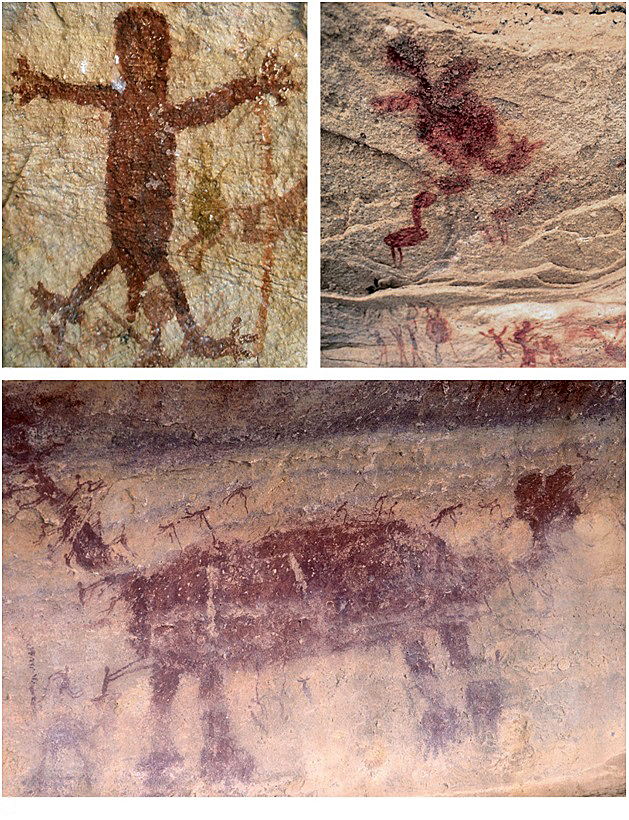
Upper Left: Anthropomorph from Extrema II, 41 cm.
Upper Right: Anthropomorph from Canoas II, c.20 cm tall.
Lower: Agreste tradition jaguar surrounded by Serra da Capivara style anthropomorphs at Baixa das Cabaceiras, jaguar c.120 cm, small figures c.6-9 cm.
Photos by Reinaldo Morales, Jr., 2021.
Following the interpretations of Pessis and Guidon, this presumed evolution of styles reached its peak with the most sophisticated paintings, those of the Serra Branca style (Figure 4.2). Because these feature “hierarchy symbols within the ethnic group,” like headdresses, masks, and other “religious vestments,” they represent the most highly evolved painting of the Nordeste tradition, dating to 7000–6000 BP.5 So certain was this overlay of painting phases onto lithic phases that when the material record at Pedra Furada suggested an abandonment at 6000 BP (Parenti 2001: 99-108), this was thought to indicate that the populations of Nordeste tradition painters disappeared completely (Pessis 2004a: 163; Guidon 1998). A new population, responsible for the subsequent Agreste lithic tradition, were thought to have immigrated to Serra da Capivara and were thus assigned credit for a subsequent and obviously very different painting style, the Agreste style, dating to around 6000–3000 BP (Figure 4.3).
Compared to those of the Serra Branca style painters of the Nordeste tradition, these Agreste paintings are rough and unsophisticated (as the Brazilian Portuguese term agreste suggests in its pejorative). This is not unlike the “decadence” of the Agreste lithic tradition, less sophisticated than (and following) the Serra Talhada lithic phase—an “involution of lithic industries around the sixth millennium BP,” as Fabio Parenti characterized it (Parenti 2001). In this ‘evolution of art’ model, Agreste paintings represented an involution of style that was bound to follow the presumed departure of the people responsible for the refined Serra Branca period style (as well as the refined Serra Talhada II lithic phase).
Willibald Sauerländer’s critique is salient to the rock art chronology that was originally proposed for Serra da Capivara, and for a raft of chronologies based on misuses of style as a chronometric tool—“the stylistic quest for chronology,” as George Kubler put it (Kubler 1970: 131). If an art historian speaks of the style of a period, according to Sauerländer, they are “in danger of understanding style as the visual expression of a social constellation…dreamt of as symbolically unified” (Sauerländer 1983: 265-266). In this model of a temporally confined and evolutionarily ordered “social constellation,” style is an inevitability of its specific phase of sociocultural evolution—a narcissistic reflection at best, an unwilling servant at worst. The force of that sociocultural evolution is the inescapable zeitgeist that insinuates itself upon the cultural developments of a given human moment, or Kubler’s unavoidable shapes of time (Kubler 1962: 32). George Kubler, for example, preferred format because style was too “heavily fraught with evolutionary associations,” and thus “not only implies but demands exclusive domination over its ‘period.’” (Kubler 1979: 170). All arts are possessed by their cultural period in this evolutionary model, and must therefore all run a parallel track with the ordered social constellation of an irresistible zeitgeist, “because the same Demiurge is active in them all.”(ibid). Subsequent archaeological and art historical scholarship has repeatedly been swept up by this methodological solution to chronologically ordering the past (Sauerländer 1983).
Style and the Linguistic Turn
Gabriela Martin has noted that by introducing André Leroi-Gourhan’s idea of graphisme to Brazilian rock art research—a term which draws little distinction between alphabetical characters and pictorial images—Pessis re-centered the analysis from one of visual art to one of language and texts (Martin 1997: 243). This follows the linguistic turn in anthropology championed by Claude Lévi-Strauss. The mid-twentieth-century linguistic turn is seen most influentially in the contributions by researchers like Lévi-Strauss, Leroi-Gourhan, and Annette Laming-Emperaire. Their students include Niède Guidon and André Prous, among the most respected and influential Brazilian archaeologists. These scholars essentially defined Brazilian rock art research for generations, an impressive academic lineage from the Sorbonne to the sertão of the Nordeste. Semiotics and evolution are closely married in this methodological turn. From Pessis’ use of graphisme (adopted from Leroi-Gourhan’s evolution of writing (Ingold 2004), the analytical discourse establishing the Serra da Capivara chronology sought to articulate an evolution of chrono-stylistic units, through scenographic, hypothetical, and conjectural analysis. This involved identifying the component graphismes (loosely translated as “graphics”), whether they are pure graphismes , graphismes of composition, or graphismes of action (Pessis 1982). The idea of an evolution of painting mated synchronously to phases of lithic development is the driving principle that resulted in the original chronology proposed for Nordeste rock art.
II. A New Century, A New Chronology
New Archaeology
The twenty-first century brought new methodologies, data, and ways of approaching rock art, providing new opportunities to build upon the pioneering work of Guidon and Pessis to generate new insights, revise early proposals, and test the chrono-style and evolution of art hypotheses. While the interpretation of this rock art benefits from the careful use of ethnographic analogy, which was anathema to structuralist readings of ancient painted texts, the focus of this essay is limited to two less subjective proposals based on the art-historical study of Nordeste rock art. The first is a revised chronology of these painting styles, a fairly conservative revision, but one that accounts for compositions that seem to contradict the clean Winckelmann-based progression (evolution) of one chrono-style after another. The second proposal offered here relates to a revision of the painting styles using the relatively uncontroversial method of formal analysis. Both proposals have implications for other rock art traditions in the Americas and the persistent debate about diffusion versus independent innovation in ancient American art.
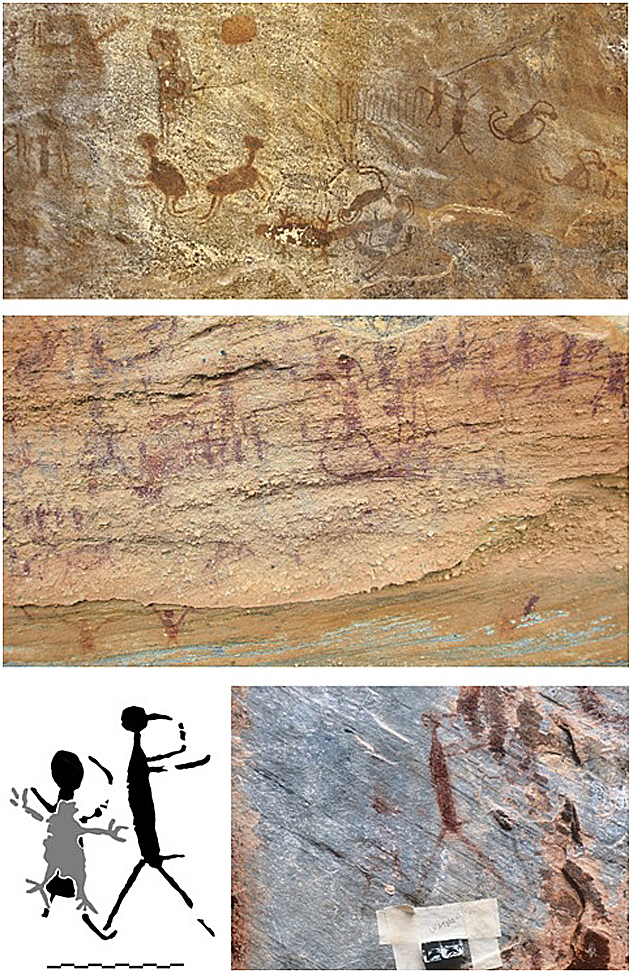
Upper: Characteristic anthropomorphic stylizations from Deitado, figures 8-12 cm. Photo by Reinaldo Morales, Jr., 2021.
Middle: Figures buried in stratified deposits as old as 9650–10530 BP at Baixão da Perna I, figures 4-12 cm. Photo by Reinaldo Morales, Jr., 2021.
Lower Left: Drawing of the heavily sampled Serrote da Bastiana figure, c.17cm tall. Drawing adapted from a photo by Niéde Guidon, after Steelman et al., 2002.
Lower Right: Serrote da Bastiana figure before 2000 sampling. Photo by Reinaldo Morales, Jr., 2004, after almost all the pigment was removed for dating.
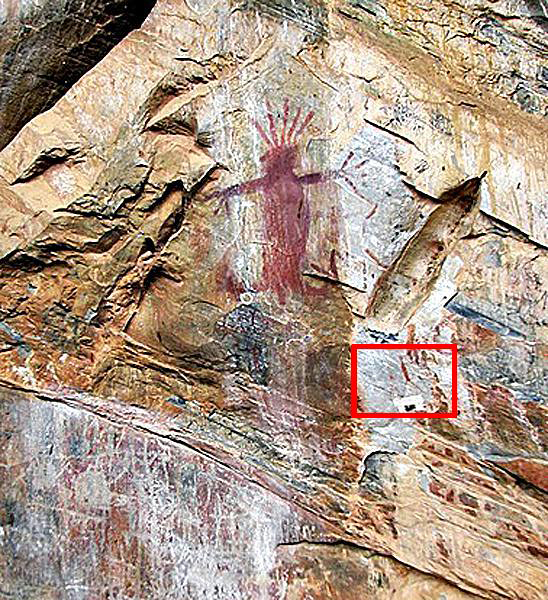
Photograph by Reinaldo Morales, Jr.
The direct sampling and radiocarbon dating of pigment samples at the turn of the century warranted a reassessment of the rock art chronology proposed in the 1980s.6 Between 1999 and 2000 paint samples were taken from a red Serra da Capivara style anthropomorph at the site of Serrote da Bastiana (Figures 4.4, 4.5). This painted figure has been sampled almost out of existence and is probably now the single most sampled and dated rock art image in the world. Using plasma oxidation and accelerator mass spectrometry (AMS) radiocarbon measurement, pigment from the sampled anthropomorph yielded a date of 3730 BP (Figure 4.4, Lower: Left). This evidence argues for revising and expanding the temporal span of the Serra da Capivara style (to 12000–3730 BP rather than 12000–9000 BP). This would mean that Nordeste tradition painting persisted beyond the presumed 6000 BP “abandonment” of the “Nordeste people,” and the disappearance of their eponymous lithic tradition (Guidon 1998: 48). The implications of these various direct dating efforts on this particular Serra da Capivara style painting are significant.
The 3730 BP painting date at Bastiana is one of a suite of direct radiocarbon measurements from paintings at Bastiana that were all in the range of only a couple of thousand years (versus the tens of millennia of disagreement in other efforts) (Guidon 2004: 140; Guidon and Buco 2006: 127; Watanabe et al. 2003:351-353). Paintings of this date should not be unexpected. There are numerous, similarly later dates for sites with paintings in this Serra da Capivara style (after the proposed 6000 BP Nordeste abandonment). Considering this evidence, it seems reasonable to accept the Baixão da Perna I dates as the earliest solid evidence of Serra da Capivara style rock art (10530–9650 BP), and reasonable to conclude it lasted until at least 3730 BP (well beyond the style’s originally proposed 9000 BP terminus). While these dates call the original chronology for Serra da Capivara style rock art into question, and make the methodology responsible for it problematic at best, it is evidence of a very persistent painting style, if indeed these various paintings are all the same style.
Stilus v. Chronos
Here is where style may fail to cooperate as some might like. It would be easy if a style indicated a clean-cut, well-measured span of time followed by a different style with its own clean-cut, well-measured span of time, and so on. But styles need not be sequential (serial)—they can coexist within a single cultural moment—nor must they have clearly defined limits. Style is incompatible with the clean-cut appearance of Linnaean evolutionary and phylogenetic taxonomic systems borrowed from the biological sciences. The idea of style representing a clean-cut, well-measured span of time has been fundamental to the evolution of the chrono-styles model, where supposedly un-evolved styles are presumed to precede more complex, evolved styles. Winckelmann’s original evolutionary model of art held that “the form of real beauty” suffered in the work of late artists because “taste declined among them, and the arts were trampled on” by political and moral decline (Winckelmann 1765: 261); art was the unwitting “mirror of a lost felicity” (Sauerländer 1983: 261). Stylistic sequence is not in question here, only artificial sequences based on a synthetic a priori proposition that art evolves like textual graphemes or biological organisms. But how can the Serra da Capivara style be both the oldest and the youngest dated rock art here? Winckelmann and his methodological progeny inebriated countless future generations of art scholars on the simple beauty of evolution in the study of very old things, “the greatest temptation of an understanding of style” (Sauerländer 1983: 262). This notion was eventually applied to many other places and times, meeting with especially poor success in the early studies of art in European caves.7 Timothy K. Earle noted how, “methodologically, the radiocarbon revolution in dating in the 1950s transformed the field of archaeology, and studies of rock art styles as a means to establish time-space culture histories were discontinued” (Earle 1994: vii). Now we can see that styles as simple to replicate as these Serra da Capivara miniatures8 (formal varieties of which occur in many rock art traditions, as considered below) cause special problems with stylistic analysis qua chronometric analysis.
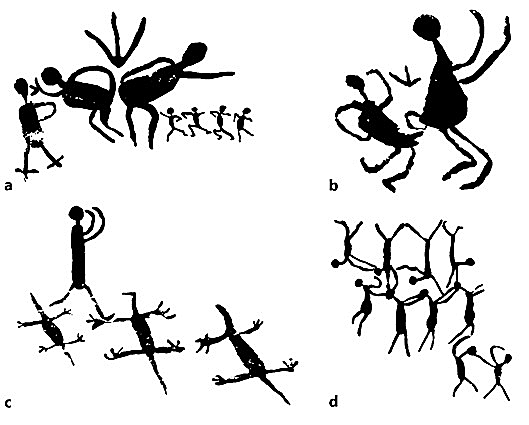
a. Entrada do Pajaú
b. Entrada do Baixão da Vaca
c. Sítio do Meio
d. Pedra Furada All figures c.6-12 cm.
Drawings by Reinaldo Morales, Jr., 2021.
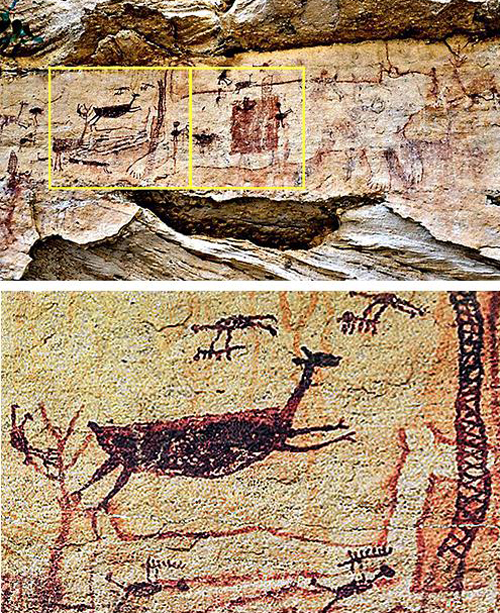
Upper: Smaller Serra da Capivara style red figures painted over a large polychrome Angelim style white jaguar, c.118 cm wide. Two similar scenes of the same subject (deer capture) highlighted, each in the same style, though probably by different artists. Note the vertical nets to the right of each scene (right net is somewhat obliterated by red patch).
Lower: Detail of upper left scene.
Photos by Reinaldo Morales, Jr., 2021.
It seems reasonable to expect that a specific, well-defined style may have a limited duration in time—a single period—but it is not reasonable to expect that a specific moment in time will have only a single style. This idea is all the more counterproductive when it is assumed that a period or place has a style that reflects the values or mental template of every artist working during that period in that place. The frequently flawed application of such temporal and spatial determinism has often proven to be more of a methodological hindrance than benefit in art historical and archaeological scholarship. For example, figures like those at the heart of the Serrote da Bastiana dating attempts are strikingly similar in style to examples from the Serra da Capivara type sites of Entrada do Pajaú, Entrada do Baixão da Vaca, Sítio do Meio, and Pedra Furada (Figure 4.6).
Also, like Serrote da Bastiana, sites with the Serra da Capivara style yielded evidence of use from 4760 BP (at Ema do Sítio do Brás) to 2700 BP (at Sítio do Meio). These are within a millennium of the 3730 BP date for the Bastiana anthropomorph. The Serrote da Bastiana dates seem even more reasonable when we consider that these sites with similarly styled paintings were being used at similarly later dates, well after the proposed 6000 BP Nordeste abandonment. One must concede that while there is a clear and early Serra da Capivara style (such as at Baixão da Perna I), other Serra da Capivara styles must have independently appeared much later (as at Serrote da Bastiana). Some of these styles are certainly intentional copies or revivals of earlier ones. That these Serra da Capivara styles appear widespread across both time and space in the region is reinforced when we examine examples that appear to violate the initial chrono-stylistic evolution.
The Serra da Capivara style figures painted over a larger polychrome jaguar at Toca do Estevo III are great examples of how two almost identical hunting scenes were painted side by side, in almost identical styles, but probably by two different hands (Figure 4.7). The left group of five anthropomorphs, a net, and a larger deer is mirrored by another composition to the right featuring five anthropomorphs, a net, and a larger deer, with an extra figure back near the left group (but clearly in the hand of the right group painter). The right group anthropomorphs have larger, rounder heads and larger, rounder torsos, compared to the scale and proportions of those on the left. The left deer is larger than that in the right group and shows more graceful drafting skills, especially in the legs and nape. The comparatively more refined brushwork and draftsmanship of the left group painter is most apparent in the two nets. This illustrates two important points: The Right Group Painter copied the Left Group Painter, whether minutes or years later; and, basic art-historical style analysis can not only identify one style from another, but can identify different painters using the same style. Significant here is that these Serra da Capivara style figures were painted over another painting, the large jaguar. The Estevo III jaguar was considered an example of the last Nordeste tradition painting style, the Serra Branca style, following the original chrono-stylistic evolution model.9
The intimate juxtaposition of Serra da Capivara style anthropomorphs around large Agreste tradition paintings at Baixa das Cabaceiras (Figure 4.3: Lower) shows that Serra da Capivara style painters were working after Agreste tradition painters. There are three prominent Agreste tradition jaguars along the rear wall of this rockshelter. Two of these large jaguars have small red anthropomorphs tightly encircling them, as in Figure 4.3: Lower. Some of these miniature anthropomorphs have outstretched appendages touching the jaguar, while others are connected to it by long lines representing projectiles (jaguars, dart throwers, and darts are very common in the iconography at sites in this particular canyon system). These examples from Baixa das Cabaceiras invert the original chrono-style rock art sequence at Serra da Capivara. In a Serra Branca style composition from Morcego, several figure types are present in a composition possibly painted by a single hand (Figure 4.2: Right). A group of Serra da Capivara style anthropomorphs, painted in a smaller scale or abbreviated technique, seems to reflect the same hand of the painter of a nearby “Classic” Serra Branca style composition. In this fashion, the smaller images clearly create a strong visual contrast with the elaborate, elongated anthropomorphs executed in a purposeful rectilinearity. At Morcego, we see an apparent intentional manipulation of form (the elements of art and principles of design) in the service of communicating something with greater effect. This is well known to students of art history and nothing new in Pre-Columbian art. See, for example, the contemporary use of a “folk” style and an “elite” style of Maya cave art at the same time in the same caves. Irene Winter (1998) and Andrea Stone (2005) have each argued that style, like iconography, can be used intentionally to carry meaning. This Serra Branca style composition from Morcego seems like a reasonable example.
III. A New World: Monuments, Migrations and Miniatures
The presumed oldest, least evolved painting style turned out to also be the most recent painting style in Serra da Capivara National Park. This is not unreasonable if this is a style or a collection of closely similar styles that were loosely shared across various temporal, and even cultural boundaries. These were experienced painters living around the eastern highlands of the Serra Bom Jesus da Gurguéia from the dawn of the Holocene (if not earlier) until at least the advent of ceramics and formal settlements by 3000 BP, at the beginning of the Nordeste Formative period. Certainly rock art was not the only form of visual expression; these painters no doubt lived in a world of many other, archaeologically transparent, painted media. Grieder cautioned that we must acknowledge that culture “is people perceiving, reacting, imagining, explaining, remembering and forgetting” (emphasis added) (Grieder 1982: 178). These very human terms allow for human proclivities like copying or reviving styles (or independently generating formally identical shorthand styles from time to time). Reactions, like copies or revivals, are part of artworlds across the Pre-Columbian Americas. We have to remember that these painters were not just observing and reacting to their world. Like all painters living in painting-rich environments, these painters were reacting to their artworlds as well.
By the advent of pottery around 3000 BP, Serra da Capivara was certainly a rich artworld, one confronting new forms and demands (such as ceramic crafts) of a new domestic reality in an emerging small village dynamic. Generations of copies of old arts were so commonly encountered by 3000 BP that a tradition of revivals of convenience may have been the norm—perhaps even the mean of the style (Grieder 1996: 140). Thus rock art itself had to compete with other painting media to the point that its (seeming) primacy in visual expression began to fade, beginning a process that led to the apparent lack of any recorded rock art traditions witnessed by the European immigrants who wrote the first textual histories of the Nordeste. Lacking later archaeologically dated evidence, a c.2500 BP terminus for the Nordeste tradition rock art is therefore proposed.
A Nordeste Formative
The onset of a Nordeste Formative around 3000 BP didn’t only inaugurate an era for Nordeste painters, it marked the advent of a new world in other significant ways. The stylistic and iconographic variability we see in this rock art may reflect cultural responses to the mid-Holocene Climatic Optimum and subsequent environmental changes. Around the time of a presumed Nordeste hiatus or abandonment (by 6000 BP), rock shelters became much less frequently used. Higher temperatures and more humid seasonal patterns then reached a maximum by 4000–3500 BP (the Mid-Holocene Climatic Optimum) (Guidon 1986; Behling 1995: 265-266; Ledru et al., 1996: 239-240). This dramatic shift was probably responsible for some of the adaptive strategies and technological changes we see in the archaeological record. The transition to the Nordeste Formative was almost as culturally dynamic as the Pleistocene/Holocene transition ten thousand years earlier. Climatological evidence suggests that there was a return of humidity after the drought conditions of the climatic optimum, by around 3000 BP. The vegetation “intensified extraordinarily,” and was characterized by “large forests in the valleys and cerrado on hills and slopes, …with a dry season of around 5 months and higher precipitation” (Behling 1995: 253; Ledru 1996: 239). Conditions became more conducive to the spread of dense cerrado and semi-deciduous forests in nearby regions. The dry season became shorter and the influence of fires on the vegetation diminished (Behling 1995: 253).
The beginning of the “New World” of the Nordeste Formative is marked at Serra da Capivara with the pottery at the site of Pinga do Boi around 3320 BP. By this time the rock shelters in the canyons were being largely abandoned or only used very occasionally. Archaeological evidence suggests that this occasional use was temporary and was not specifically connected with domestic activities (Vidal, personal communication).10 The return of more permanent water sources would have enabled an abandonment of the rock shelters as occupational sites in favor of other, more permanent locations in the landscape. The proposed Nordeste abandonment might have been a result of the increasing archaeological transparency of the adaptive strategies employed by bands of hunter-gatherers moving into new environmental niches—out of the rock shelters and into the open. By this time the environmental conditions we see today were fairly well established in Northeast and Central Brazil (Sheel-Ybert, and Bachelet 2020: 285–286).
1492 BCE
It is somewhat poetic that the calibrations required to convert radiocarbon years (BP) to calendar years place the year 1492 BCE squarely in the range of the uncalibrated radiocarbon date of 3320 BP for the ceramics from Pinga do Boi (Bronk 1998; Hogg 2020). The date 1492 BCE used here for rhetorical purposes similarly refers to a range of hundreds of years. It broadly points to the adoption or influx of Formative lifeways across Brazil, but we can see fundamental changes in societies across the Americas as well. There was a marked increase in the number and size of Formative sites in the Amazon, including sites with elaborate ceramic assemblages.11 Regarding other areas of South America, Pozorski and Pozorski note that the Initial Period along the Pacific Coast (2100-1000 BCE) was “the time of decisive cultural innovations…a dynamic time of remarkable cultural achievements. Suddenly,… at least a half a dozen cultural developments or polities” appear (Pozorski and Pozorski 2008: 614). Farther north, John Hoopes notes that “Mesoamerica experienced a veritable explosion of ceramic styles between 2000 and 1500 B.C.” (Hoopes 1994: 28). Around this consequential time the earliest reliably-dated Mesoamerican cave paintings appear. At Oxtotitlán, oxalate accretions overlaying rock art date to 1520–1410 BCE, “a terminus ante quem marker,” for the Early Formative polychrome painting at the site, “the earliest evidence for this medium in Mesoamerica” (Russ et al., 2017: 179).
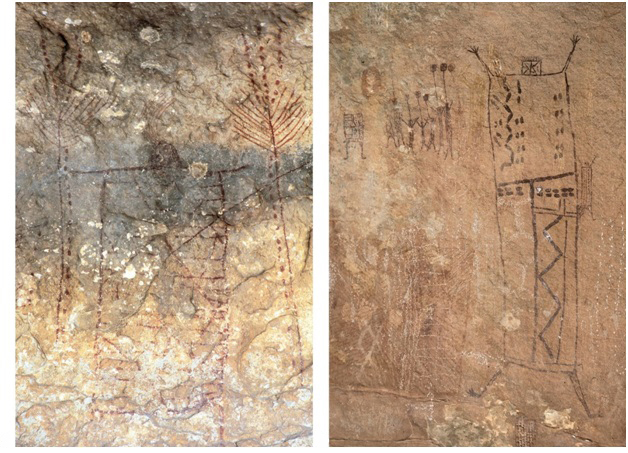
Left: Pecos River style figure at Fate Bell Annex, Seminole Canyon State Historical Park, Texas, c.190 cm tall.
Right: Serra Branca style figure at Morcego, c.170 cm tall.
Photos by Reinaldo Morales, Jr., 2021.
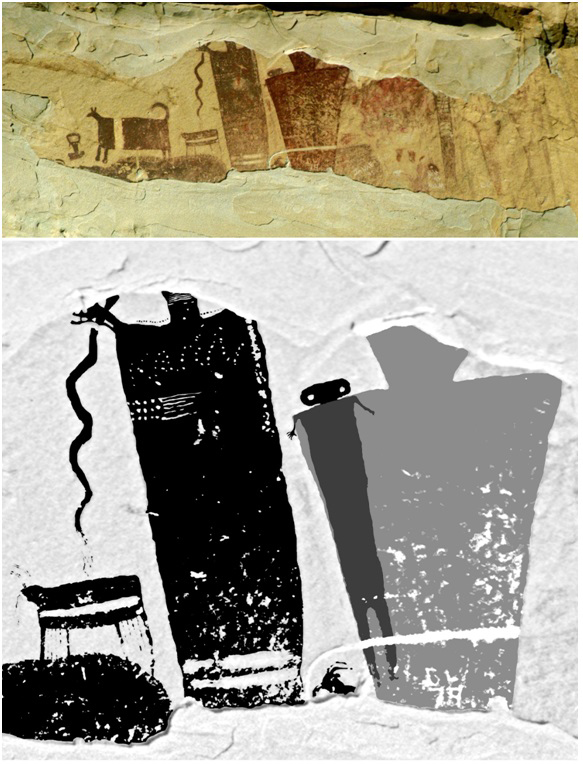
Photo and drawing by Reinaldo Morales, Jr., 2021.
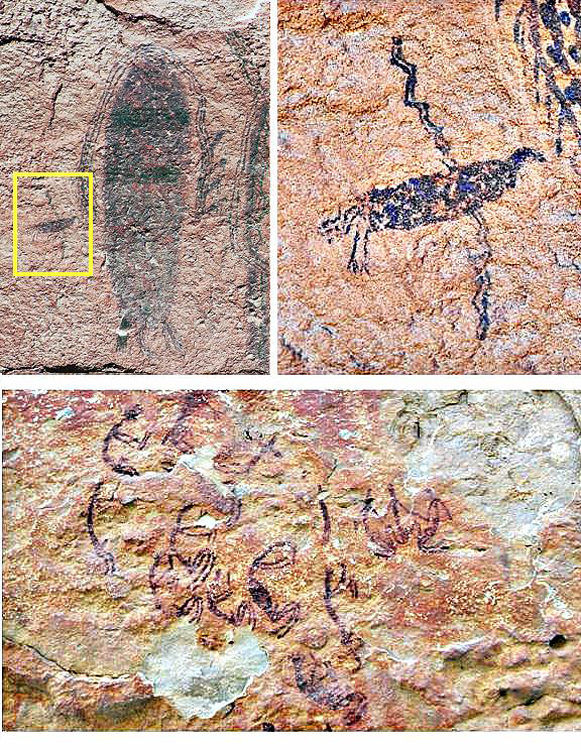
Upper Left: Barrier Canyon Style anthropomorph(?), c. 22 cm. tall; detail from a larger composition, from central Utah.
Upper Right: Detail enlarged from upper left figure. Polychrome Barrier Canyon Style bird c.35 mm long, with some lines less than one millimeter wide, one of several small animals surrounding larger figures in this composition.
Lower: Composition of Red Linear Style figures, c.10 cm each, with appendages only a few millimeters wide, from Seminole Canyon State Historical Park, Texas.
Photos by Reinaldo Morales, Jr., 2021.
The American Southwest saw a new world with the Late Archaic arrival of increased humidity and the sub-boreal interval, or Medithermal, after the Middle Archaic Altithermal drought.12 A number of major rock art styles, primarily painted (as opposed to carved or “petroglyph” imagery) arose throughout the region during this time, the most notable of which include the Pecos River Style, Barrier Canyon Style, and the Grand Canyon Esplanade Style (Boyd 2013, Schaafsma 1980; Christensen and Dickey 2004a; Dickey and Christensen 2004). The adaptive strategies that the hunter-gatherers developed as responses, certainly included changes in the arts. Solveig Turpin points to a combination of ritual activity with new aggregation and dispersal patterns in the rock shelters along the essential watercourses of the Lower Pecos River region (Turpin 1994). Pecos River Style rock art, Turpin argues, may have been one response to the new social frictions and fractures resulting from the new ecological demands. These monumental polychrome murals date to the late Middle Archaic (2100–1200 BCE) (Boyd 2013: 19). The most recent (January 2021) and by far the most secure dating of an Archaic Southwest painting is from one of the iconic Pecos River style sites, Eagle Cave. Using both the direct sampling of the pigment and the dating of the accretion covering it, the method we saw at Serrote da Bastiana, Karen Steelman and colleagues report a weighted average of 3280 ±70 BP for the paintings (a median date of 1556 cal BCE) This latest of several direct dates “firmly places the production of the dated [Pecos River style] figures at the end of the Middle Archaic in the Lower Pecos,” around 1492 BCE (Steelman et al., 2021: 9). The similarity in the rendering of monumental anthropomorphs between this Pecos River Style and the more-or-less contemporary Nordeste Serra Branca style seems remarkably striking (Figure 4.8).
Further north, on the Colorado Plateau in modern-day south-central Utah, a similar and fairly contemporaneous Archaic new world played out with Barrier Canyon Style rock art, dated c.5000? BCE-1000 CE (Figure 4.9) (Schaafsma 1980; Farmer, this volume). This significant corpus of rock art appears to have been one of the adaptations an artworld made around our rhetorical 1492 BCE moment. Phil Geib described in detail how these hunter-gatherers may have adapted to the Middle- to Late-Archaic upheavals in seasonal resource procurement. A significant increase in site use occurred in the region during the second millennium BCE, contemporary with 1492 BCE. The Barrier Canyon Style emerges as one of the most impressive and distinct artworlds in the ancient Americas (c.5000? BCE-1000 CE) (see Farmer, this volume and 2001; Geib 1995). It is important to note that these Barrier Canyon Style painters were not only master muralists but also master miniaturists. It is common to find figures often over a meter tall with miniature animals around them, barely 20 mm long with clearly articulated details like horns or feathers (Figure 4.10: Upper), in millimeter-wide brushstrokes interspersed among compositions of larger figures visible to the naked eye over a half mile away. Miniaturism was combined with monumental painting intentionally as a means of expression.
“Reacting and remembering” are as much a part of Pre-Columbian cultural dynamics as innovation and diffusion (Grieder 1982: 178). Formal influences of the Barrier Canyon Style painters and their inescapable artworld are evident in the rock art images of the later Fremont culture of the same general area, c.700-1300 CE (Schaafsma 1980: 61). Fremont people, contemporaries of the early Ancestral Puebloan peoples to the south, were former hunter-gatherers transitioning to the new world of the Formative, developing incipient horticultural and associated sedentary life styles, nascent architectural traditions, and early ceramics, while looking back in time to the artworlds they inherited. Fremont rock art style imagery includes impressive engravings as well as monumental paintings, similar to, but distinctly different from earlier Barrier Canyon imagery. Perhaps most intriguing from an art-historical perspective are the instances of ancient Fremont artists apparently paying homage to their Archaic forebearers. Sites like the Temple Mountain Wash site, in the San Rafael Swell region of central Utah (Figure 4.9), demonstrate how Fremont paintings were carefully composed to appropriate, accentuate, copy, and adapt Barrier Canyon Style motifs. In the San Rafael Swell example, a large Fremont figure was intentionally superimposed over an older Barrier Canyon Style figure. The shoulders and torsos align in such a way as to create the appearance of a Barrier Canyon Style head resting on the shoulder of a Fremont figure. These are eloquent examples of early American artists reacting to a rich and sophisticated artworld from the past. They did so in a manner that reveals an awareness of the aesthetic impact such technically distinguished images have upon viewers, especially when presented on the monumental scale we see in the San Rafael Swell example.
In the Trans-Pecos region of west Texas, we also see sites with a distinct miniature painting tradition labeled the Red Linear style (Figure 4.10: Lower). Recent scholarship confirms that this style and the more monumental Pecos River style were generally contemporary (Boyd et al., 2013), just as we see Serra da Capivara style miniaturism contemporary with presumably later, larger-scale painting styles in Brazil’s Nordeste. Nothing about miniaturism precludes it from being one of several aesthetic strategies exploited contemporaneously with large-scale mural painting—one style does not have to be chronologically, evolutionarily, or ethnically segregated from the other. Each style of painting could have simply served different purposes for the same people, people who were clearly skilled enough to express themselves in any manner they thought necessary (just as in-situ stone was certainly only one surface they painted on). There appears to be a fluorescence of painted rock art beginning with the end of the late Middle Archaic with its drought-related climatic stress, and this seems to continue vigorously through the Late Archaic, right up to the first experiments with a Formative lifestyle in the Southwest.
A Pan-Archaic Fluorescence?
The Serra da Capivara rock art and archaeological record reflects a similar series of radical changes peaking around 1492 BCE, with the appearance of ceramics at sites like Pinga do Boi and Morcego (Martin 1997: 216). At sites like these we also see some of the most sophisticated paintings in Brazil. These may be among the last paintings in the Nordeste tradition, as the original chronology proposed, though solid dates like those for the Serra da Capivara style are still lacking for these paintings. What we do have are several unique styles that share a strong iconographic underpinning. These painting styles are related to each other by a larger tradition, as Guidon and Pessis first recognized. An analogy from Western civilization might be the various relief sculptures around late Medieval European church portals between c.1000–1500 CE, which share common iconographic themes but represent a range of regional and temporal differences in sculptural style. The archaeological reconnaissance at these sites shows that they were used after the presumed 6000 BP end of the Nordeste tradition, yet they provide some of the most refined rock art examples of that tradition. This level of refinement makes them attractive candidates for a last style in a series or an evolution of styles from simple to complex, and consistent with the proposed c.2500 BP terminus for the Nordeste tradition, if such a sequential formal development across time were the case for Serra da Capivara rock art.
The Serra Branca and Angelim Styles
The Serra Branca style was originally proposed as the end of the Nordeste culture’s painting tradition based on the impressive compositions found at sites in the Serra Branca region in the remote northwestern reaches of the national park. A hallmark of this style is a distinct, sometimes severe, torso elongation, extreme attenuation of appendages (occasionally absent), use of abstracted heads and torso patterning, and a static, orant pose (frontal with arms outstretched). A pair of yellow figures from the site of Caboclo show the careful brushwork common in this style, made even more impressive by the scale of the largest figure, around seventy centimeters tall (Figure 4.2: Left). This rectilinear elongation, three-register torso patterning, and static, orant pose are also repeated characteristics of form we see in other Serra Branca figures at Caboclo. We also see this formal convention in other Serra Branca style paintings, like the monumental figure at Morcego and the compositions at Boqueirão do Paraguaio II (Figures 4.8: Right and 4.11). The Morcego figure is around 170 cm tall with both finger-painted and brush-painted lines, some only a few millimeters wide, with a slightly shorter but far more narrow yellow figure in profile to the left. Illustrating one of Pessis’ emblematic compositional themes, this frontal-profile pair is juxtaposed with a large, 90 cm deer a meter to the right. This is a fairly standard compositional convention in the Serra Branca style, one we also see at Boqueirão da Paraguaio II.
One of the frontal-profile pairs at Boqueirão da Paraguaio II is painted in a different manner than the sharp-cornered Serra Branca style figures at Morcego. This pair, two of a dozen figures, has a large attending deer to the left, anchoring the impressive painted panel at this site (Figure 4.11). The deer is 120 m tall, from hoof to rack, and the larger anthropomorph is 73 cm tall, with some lines barely over a millimeter wide. In addition to the sophisticated painting techniques, there is a distinct formal feature which these figures share with dozens of other sites around Serra da Capivara, which I have labeled “open-contour appendages”. This is a key formal diagnostic element which I have designated the “Angelim Style” (Morales, Jr. and Risatti 2019), now recognized as a distinct variation of the broader Serra Branca style. A scene from Pinga do Boi is another strong example of painterly sophistication and importance of form of one of these open-contour Angelim-style paintings (Figure 4.12). Half-centimeter white lines were painted first, providing the shape of the large, central deer, including three distinct sets of interior patterns. These white lines, which have faded considerably, were then outlined by thinner red lines with the ends of the visible appendages left open, terminating in graceful fluted lines.
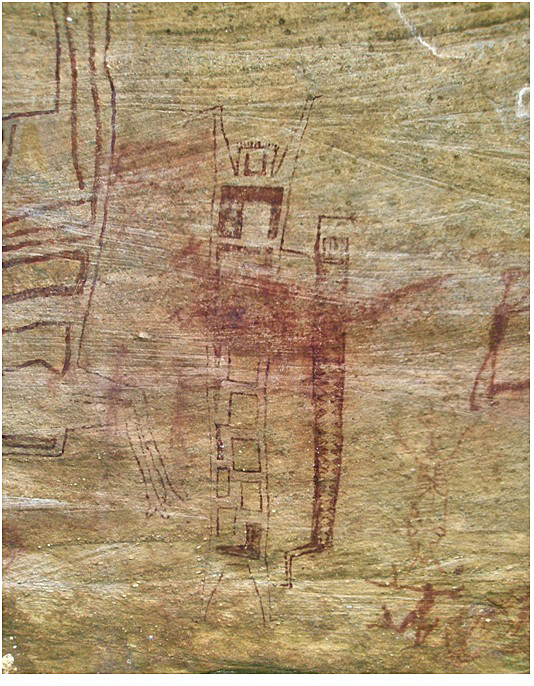
Photo by Reinaldo Morales, Jr., 2021.
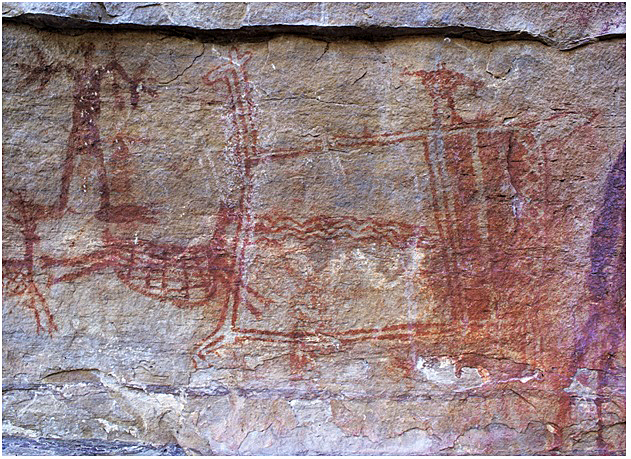
Photo by Reinaldo Morales, Jr., 2021.
These Serra Branca and Angelim styles were originally lumped together as a single, tradition-ending style. An iconography-based methodology that sought cultural themes as indicators of social evolution did not recognize the distinct manner of painting represented by the Angelim style. Approaching these paintings, however, as formal evidence of changes in cultural context, by means of careful art-historical approaches to an analysis of style (i.e. the “configurational” method of Kubler and Grieder), allows a much more sophisticated understanding of the true diversity of the prehistoric artists who created these images.
A Piauí Homeland?
A style-based analysis also verifies, to an extent, the widespread distribution of some of the painting styles to other parts of the Nordeste, and to more effectively assess whether far distant paintings might indicate far-flung cultural progeny of the Serra da Capivara populations. An unofficial but widely accepted ‘Out of Piauí Model’ of sorts has permeated Brazilian archaeology over the decades since the 1970s rediscovery of the rock art at Serra da Capivara. Paintings that resemble Serra da Capivara miniatures have been found in Bahia, Rio Grande do Norte and other states in the Nordeste (Figure 4.13: a-c). These have been considered evidence of migrations out of Piauí around 9000 years ago (Martin 1997: 266). This, however, is based on the chrono-stylistic evolution model that isolates the Serra da Capivara style in the earliest millennia of the Holocene. Because the miniature painting tradition in Piauí represented by the Serra da Capivara style(s) persisted through the Holocene to the advent of the ceramic horizon, (or the Nordeste Formative as referred to here), we must re-assess the 9000 BP origins of this artistic diffusion.
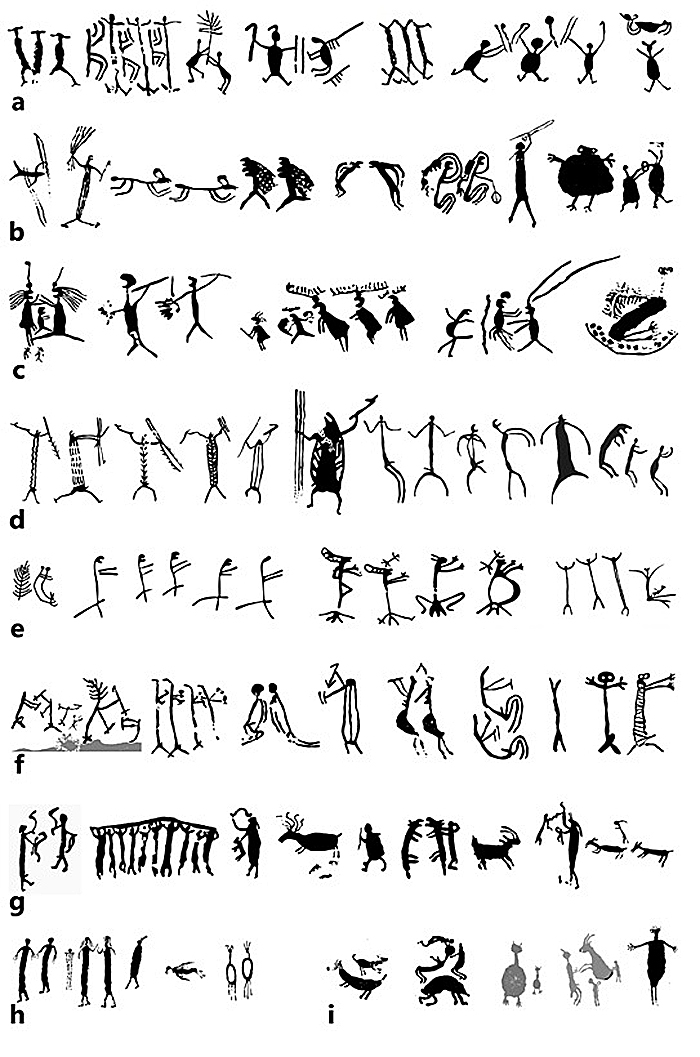
a. Serra da Capivara National Park, Piauí (Brazil)
b. Chapada Diamantina, Bahia (Brazil)
c. Seridó region, Rio Grande do Norte (Brazil)
d. Serranía de Chiribiquete National Park, Colombia. Drawings adapted from Castaño-Uribe 1998.
e. Pair of miniature figures with plant motif (far left) from Peruaçu Caverns National Park, and three groups of larger (25-35 cm) figures from the Lagoa Santa region, Minas Gerias, Brazil. (drawings adapted from Prous, Baeta, and Ruboli 2003)
f. Seminole Canyon State Park, Texas (USA)
g. Lincoln National Forest, New Mexico (USA)
h. Barrier Canyon Style, Utah (USA)
i. Kanab Plateau, northern Arizona, USA (adapted from photos by James Farmer)
All drawings by Reinaldo Morales, Jr., 2021, except where indicated.
Some notable examples of South American rock art seem to stretch the notion of direct transmission of a style even though they share a lot of the formal qualities we see in the Serra da Capivara paintings (Figure 4.13). Some small stick-figure and similarly simplified figurative paintings and drawings in Peruaçu Caverns National Park have been considered evidence of a Nordeste intrusion, implying that local populations were not responsible (Figure 4.13:e) (Prous 1994). This semi-subterranean river and cave system in Minas Gerais is another of Brazil’s most important concentrations of rock art. At only 700 km south of Serra da Capivara, not much farther than the Nordeste outlier in Rio Grande do Norte, nothing about the distance precludes the transmission of a style between the two areas. These appear to be late and less painterly contributions to the Peruaçu artworld. But formal analysis reveals that there are significant differences between the Peruaçu examples and their presumed Serra da Capivara style progenitors in Piauí. Elaborate, elongated anthropomorphic figures documented in the national park established around the Chiribiquete highlands in southern Columbia (Figure 4.13:d) are similar to those in Serra da Capivara and the northern Chapada Diamantina in Bahia (Figure 4.13:b). We see this especially in the finely-detailed anthropomorphs wielding dart throwers, around 15–20 cm tall with elongated torsos and frequently with C-shaped heads. The C-shaped head is a diagnostic stylistic quality of the Nordeste miniature tradition in Bahia and Rio Grande do Norte (Figure 4.13:c), but practically absent in Piauí. The Minas-Piauí connection seems less plausible than the Bahia-Piauí connections, and the Colombia-Piauí similarities are probably coincidental, but these are excellent cases for more granular, detailed studies.
Farther Afield: Diffusion or Invention?
In arid and semi-arid regions throughout South and North America we can find candidates for a trans-American stylization that, without further evidence, appear to be independent innovations of form. Archaic rock art of the American Southwest shares in this tradition, so much so that there has been a long-running discussion of cultural connections between the Colorado plateau and the Trans-Pecos region of southwest Texas (Allen 2004; Christensen and Dickey 2004b). The formal hallmarks of these styles include a distinct, sometimes severe, torso elongation, extreme attenuation of appendages (occasionally absent), use of abstracted heads and torso patterning, and a static, orant pose—almost exactly as seen in some Nordeste styles (Figure 4.14). Lekson has offered a view of Southwest prehistory that engages long-distance cultural similarities like those we see among these elaborate painting traditions. He asks: “What picture would emerge if we began our thinking about the Southwest with the premise that it and its subregions were more likely interconnected than otherwise?” (Lekson 2008:8). Why should we assume that Archaic, highly migratory painters of the Colorado Plateau knew nothing about distant painting traditions and ideologies to the south in Mesoamerica or to the southeast along the Rio Grande? As Stephen Lekson once again points out, in the ancient Americas, long distance communication and knowledge sharing were never really an issue; quoting Alice Kehoe: “Distances can be dealt with. Long distances did not intimidate Native North Americans.” (Lekson 2008: 9).

a. Barrier Canyon style composition with stylized anthropomorphs interacting with a miniature bird and mountain sheep, central Utah (USA) (animals c.12-20 mm)
b. Nordeste tradition composition with stylized anthropomorphs interacting with miniature birds, central Bahia (Brazil) (birds c.15-20 mm)
c. Examples of different modes of figural abstraction in the Barrier Canyon Style from Utah (scale varies)
d. Pecos River Style polychrome figure from Texas, c.110 cm, showing the rectilinear stylization and refined draftsmanship (cf. Farmer, this volume, Figure 2.2).
e. Examples of different modes of figural abstraction in Brazil’s Nordeste tradition (scale varies).
Drawings by Reinaldo Morales, Jr., 2021.
A similar discussion surrounds the miniature paintings of the Red Linear style of the Trans-Pecos region and those found in the mountains of West Texas and the Guadalupe Mountains of southern New Mexico (Figure 4.13: f-g). Early research by David Gebhard attempted to discover a seriation in the various styles of the Trans-Pecos, concluding that the miniature, mostly red paintings followed the larger, more elaborate paintings (Gebhard 1960). This was also the conclusion of later research by Grieder, who noted features of the compositions that apparently reinforced their isolation as a period in themselves, and a chronology consistent with Gebhard’s (Grieder 1966). When comparing the shorthand miniature paintings in Northeast Brazil to these various miniature styles of the middle Rio Grande drainage, they appear to be just as similar to those of the Trans-Pecos and the Guadalupe Mountains as those two styles are to each other. More than just a comparison of iconography and interpreted themes is needed to demonstrate stylistic similarities; miniaturism and deer hunting themes are insufficient to rule out a coincidence of formal convenience and presume a culturally-unified tradition. Little evidence indicates a stylistic connection between ancient rock art painters situated in modern-day Texas and New Mexico, unless such a broad connection is drawn that the Nordeste painters would have to be included. These are, in the absence of further evidence, most likely independently developed painting traditions unbound to any presumed evolutionary chronology of style.
IV. Solutions and Complications
As Grieder notes, “some kind of migration is a factor in virtually every society—with migrants providing unconventional responses in their new environments and starting new chains of inventions” (Grieder 1982: 10). Artworlds as a cultural trait were neither new or invented in the New World; they no doubt were part of the cultural matrix of the earliest migrants. But rich new artworlds subsequently developed, reflecting the unique societies who occupied practically every environmental niche in the hemisphere. Yet, once here, art did not evolve in the same manner as traditionally defined archeological materials or processes, or even biological organisms or languages and writing (i.e. human evolution). One must keep in mind however, that Danto’s ‘artworld’ is as much an ideological construct (if not more so), as it is a physical galaxy of people and material things (art works). In this regard, ‘migration’ may well refer only to the transfer or exchange of ideas, as opposed to physical relocation or exchange. And somewhat ironically, the transfer of “ideas” (i.e. a sense of styles or technical expertise) ultimately requires only minimal physical contact between members of disparate groups; a serendipitous, random one-on-one conversation between two long-distance traders along an ancient trade route, in a manner quite different from Grieder’s broader notion of large, migratory populations (cf. Tate, this volume, Figure 3.13).
Evolving Methods
Pictures are not words, and vice-versa; the paintings addressed here are not pictographs. This relic terminology from the heyday of nineteenth-century epigraphy implies an unevolved form of picture-writing that will one day become a fully evolved writing system, and implicitly devalues and denigrates any painterly or artistic merits of the imagery. Contemporary art historical methodology assumes quite the opposite; these are “complete” visual expressions (i.e. “works of art”) created in the most sophisticated and intentional manner possible by the original artists. Art does not inevitably evolve over time like we presume languages do (glottochronology). A sincere evaluation of archaeologically distant rock art styles necessitates the incorporation or adaptation of any biological or linguistic approaches and associated data with a dedicated and more productive art-centered analytical framework (“art history”). Above all, modern art history methodologies no longer assume that simple or so-called schematic art must be considered an early style, and more complex or naturalistic art a later style.13 Formal evolutions and changes in art styles can no longer be so simply explained.
The miniature paintings of the Serra da Capivara style present so few formal differences between oldest and youngest that style as a chronological marker is problematic to the point of practical uselessness. These miniature brush-painted styles from across the ancient Americas are so easily invented, replicated, and modified to personal tastes that their presence in one region does not mean that their presence in another region indicates contemporaneity or cultural connection. Nor (and perhaps more germane to this essay) can one assume, as the earliest Nordeste scholarship did, that the general similarities between miniature styles and large scale varieties must reflect both cultural and archaeological contemporaneity and origin.
Waves of Culture
That the paintings in these regions share a common iconography is unimportant to this issue; these almost global similarities in subject matter are what one would expect of deer hunters painting their deer-hunting world. Iconography is not style; specific formal qualities are not generated solely by subject matter, although some styles can have associated iconographies. Likewise, nothing about style requires that the miniature paintings of the Trans-Pecos region, for example, must have come sequentially after or before the polychrome mural tradition.
In Origins of Pre-Columbian Art, Grieder argued that “Any culture is the product both of heredity from cultures which are ancestral to it and of its own adaptation to its environment” (1982: 4). He proposed a three-wave peopling of the Americas, and with each wave came distinct art traditions. These “waves” are now believed to have been from internal population movements in the middle Holocene (c.8000-4000 BP). Despite “at least four genetic exchanges between South America and other regions,” a recent study of genome-wide DNA samples from forty-nine individuals concludes, “all the ancient South Americans descend from the same Eurasian source population” (Posth et al., 2018: 1189-1192.). If Grieder’s “waves” were to be tested against the rock art addressed here, we would find that a “First Wave” must include the earliest Serra da Capivara rock art. In fact, the oldest communities in Brazil share a distinctive genetic ancestry c.12800 BP with the formerly “First” Americans, the Clovis people (the Anzick-1 genome) (ibid). This is practically contemporary with the oldest confirmed occupants of Baixão da Perna I (12706–11998 cal BP). Cosimo Posth and colleagues (2018) also discovered evidence of a major expansion event, a second wave, out of the Andes around 4200 BP, which “is notable in light of the increasing density of sites in this region at approximately this time, a pattern that is consistent with a demographic expansion of a previously more restricted population”(ibid). A second, Late Holocene wave would have not only adapted to their new worlds, but to the old artworlds already thriving in those consequential centuries leading up to 1492 BCE.
An Art History of Rock Art
Stylistic similarities, especially those that are so striking that they beg to be treated as a single cultural phenomenon (related migratory groups sharing miniature painting styles across Northeast Brazil or across West Texas and southern New Mexico), require a sensitive connoisseurship to discern, a careful eye for stylistic analysis and attribution, and, above all else, an acknowledgement that painting styles do not change across time like tool types or ceramic series. Just as Alfred Gell urged anthropologists to use the best anthropological methods in the development of an “anthropology of art” (Gell 1998), so should art historians apply the best art-historical methods to the art history of rock art.
As such, formal and stylistic analyses are still most powerful interpretive tools. We can identify a single hand working at many sites, and we can confirm significant similarities between the rock art from different regions. But what does that mean? Was there a unified Archaic ideology and tradition of form shared among those distant “cousins in culture,” the Nordeste Tradition of Brazil (Figure 4.13: a-c), the Pecos River Style (Figure 4.13: f), the Barrier Canyon Style (Figure 4.13: h), and the Grand Canyon Esplanade Style (Figure 4.13: i), as Grieder might say (Grieder 1982: 175)? These seem like remarkable consistencies in regions of the ancient Americas up to c.5000 miles apart. Were there truly, as Stephen Lekson asserts, no coincidences (Lekson 2008: 8-9)?
Perhaps somewhat ironically, one finds one’s self reconsidering a philosophical stance popular a century ago. Contemporary with Wölfflin’s (now untenable) notion of a racial character that determines “the style of individuals, periods, and peoples” (Wolfflin 1950: 11), T. A. Joyce proposed such a solution for the widespread iconographic tradition of the so-called Weeping God in Pre-Columbian art: “This link may be forged of nothing more than a community of thought, but even so it affords strong evidence that the various manifestations of ancient American culture possessed at least a common psychological element” (Joyce 1913: 373). Psychoanalysis of long dead people is no longer as popular as it was in 1915, so we must look for a more reasonable explanation.
One most obvious (and arguably overused/abused) argument here has been the use of “shamanism” to explain shared ideologies and practices, as these were widespread throughout the Americas and probably date back to the earliest trans-Pacific migrants (a point emphasized by Grieder in Origins of Pre-Columbian Art, 1982). By extension, and lacking much solid evidence to the contrary, associated ancient rock art imagery has long been assumed to reflect heavy shamanic influence, particularly regarding issues of content or subject matter, or the function of rock art sites. Yet, much ethnographic evidence in Brazil indicates that shamans have only a circumstantial relationship with the actual production of Brazilian rock art. Among a number of well-studied indigenous Brazilian societies, artistic production is not the purview of the shamans, but that of the sponsors of specific ceremonies where the presence of the spirits is required. The painters might have been religious specialists/shamans, but the research suggests that the painters may also have been members of the community for whom the depicted personages or spirits were summoned (Coimbra 2004; Maybury-Lewis 1967; Morales Jr. 2002). But the issue under consideration in this essay is primarily an issue of form and style, particularly as addressed by the “configurational analysis“ methodology first asserted by George Kubler and Terence Grieder in the early 1970s (Grieder 1975). Despite wide-ranging scholarly popularity of shamanism as a tool of interpretation, specific criteria of form or style have never really been adequately or clearly defined for so-called “shamanic” art. To refer to any specific art form or imagery as “shamanic” in style is about as useful as referring to a specific category of “European” art. The shamanic argument simply has little bearing on the issue of style as considered in this essay.
In examples like the Serra da Capivara miniatures we see that a style is not necessarily limited to a single, short period of time; examples from the Trans-Pecos region, among other areas, show that different styles can coexist in any given period. Additionally, more recent archaeological data and a “configurational analysis” approach indicate that those of the Nordeste tradition in ancient Brazil did not “evolve,” and certainly did not do so in perfect unison with lithic or other archaeologically determined sequences.
Rock art, as a discrete medium of visual expression, continues to be perhaps the most challenging art form to interpret, particularly styles of long past and pre- or non-literate societies. Critical art-historical criteria fundamental to any analysis of artworks (when? who? how? why?), are often only generally hinted at or completely lacking; cultural contexts, social, environmental, and economic factors, and even “baseline” data, such as how many examples of a style exist, or even seemingly mundane matters, such as size, scale and location, most often can only be deduced through hypothesis. For example, much evidence suggests that the unpainted rock surface and associated geologic features extending beyond the painted imagery were, in fact, intended to visually interact with and be viewed as part of the painted composition (see Farmer, this volume). In such cases, exactly how are modern eyes even supposed to assign precise measurements or dimensions to a given work? To complicate matters further, many areas rich in rock art imagery, such as the Nordeste region or the American Southwest (or for that matter the great Paleolithic cave art of France and Spain) have only attracted the attention of serious scholarly research in the past 100 years or so. In many cases, we are still documenting new sites and establishing basic “catalogs” or databases.
What art historians assumed constituted ‘style’ a century ago – a “known” known – is no longer entirely accurate. Initial, archaeologically-based interpretations of Nordeste painting traditions produced a certain “art history” of the style. Subsequent archaeology, based in part on technological advances in the field, offered a revised “art history.” Both approaches were hampered by a dependence on relatively outdated, even antiquated anthropological and art-historical methods and assumptions. This essay offers an-updated, more interpretively robust understanding of the history of Nordeste rock painting, through the application of sound art-historical methodology, including scientifically-accurate data. We rationally and repeatedly challenge the “knowns,” while simultaneously engaging the “unknowns,” and accommodating methodological flexibility within new approaches.
Notes
1. See Guidon 1984; 1986; Parenti 2001; and Pessis 1999.
2. This approach is not new in this investigation; similar reconsiderations of other rock art styles and chronologies have been recently revised based on similar research; see Boyd et al. 2013; and Fontugne et al. 2013;
3. Guidon, personal communication, 1998. See Guidon 1986; Pessis 2003: 135-137; Parenti 2001: 99; Pinheiro de Melo 2004: 129, 276).
4. See Alvarenga and Fátima da Luz 1991; Guidon and Arnaud 1991; Martin 1997; Pinheiro de Melo 2004; Pessis 1999; and Roosevelt 1999.
5. See Pessis and Guidon, 1992: 24; Pessis 1999: 69-72; Pessis 2003: 202-227; and Pessis 2004a: 161.
6. See Steelman et al. 2002; Morales, Jr. and Steelman 2005; Steelman 2005; Rowe and Steelman 2003; and Steelman and Rowe 2005.
7. See Bahn 1998: 62; Pettitt and Bahn 2015; Pettitt and Pike 2007; and Whitley 2000: 48.
8. For the purpose of this essay, “miniature” refers to small-scale painting styles that require very fine brush flags a few millimeters wide, at most, and figures that are generally 5-10 centimeters in size. This is in contrast to the monumental painting traditions addressed here, where figures are a meter or more in size and in many cases can be seen from hundreds of meters away. Miniaturism is typically associated with images intended for intimate or personal viewing, whereas monumentalism is typically associated with public art meant to broadcast to a large audience.
9. Guidon 1984: 183. This was originally identified as a Serra Branca style painting. Subsequently this has been identified as an example of the Angelim style (Morales Jr., “The Angelim Style,” and “Nordeste Painting”).
10. Irma Asón Vidal, Fundacao Do Museu Do Homem Americano , São Raimundo Nonato, Brazil, personal communication, 2016.
11. See Oliver 2008; Heckenberger 2008; Grieder et al. 2009; Hoopes and Fonseca, 2003; Hoopes 1992; 1994.
12. See Jennings 1986: 113; Schaafsma 1981: 64; Geib 1995, 1996a, and 1996b.
13. Unfounded assumptions like these are not unusual. When the Paleolithic art was discovered in Chauvet Cave in southern France in 1994, it shattered the expectations of the previously held chrono-stylistic models of Abbé Breuil and Leroi-Gourhan; see Pettitt and Bahn 2003, “Current Problems in Dating.”
Works Cited
Allen, Mary
2004 “Comments.” American Indian Rock Art 30:86.
Alvarenga, Leonete, and Maria de Fatima da Luz
1991 “Interpretação estilística de painéis do sítio Toca do Baixão do Perna I e sua aplicação na cronologia das tradições rupestres.” Annais do Iº simpósio de pré-história do Nordeste Brasileiro, CLIO – Serie Arqueológia 4:137–140.
Bahn, Paul
1998 The Cambridge Illustrated History of Prehistoric Art. Cambridge: Cambridge University Press.
Behling, Hermann
1995 “A High Resolution Holocene pollen record from Lago do Pires, SE Brazil: vegetation, climate and fire history.” Journal of Paleolimnology 14: 253-68.
Boyd, Carolyn E.
2013 Rock Art of the Lower Pecos. Texas A&M University Anthropology Series, Volume 8. College Station: Texas A&M University Press.
Boyd, Carolyn E., et al.
2013 “A Reassessment of Red Linear Pictographs in the Lower Pecos Canyonlands of Texas,” American Antiquity 78, no. 3:456–482.
Bronk Ramsey, Christopher
1998 “Bayesian Analysis of Radiocarbon Dates.” Radiocarbon 51, no. 1 (2009):337–360.
Christensen, Don, and Jerry Dickey
2004a “The Esplanade Style: A Reappraisal of Polychrome Rock Art in the Grand Canyon Region, Arizona.” American Indian Rock Art, 30:69–85.
2004b “A Reply to Comments by Allen.” American Indian Rock Art, 30:87.
Coimbra, Carlos E. A. Jr., et al.
2004 The Xavante in Transition: Health, Ecology, and Bioanthropology in Central Brazil. Ann Arbor: University of Michigan Press.
Danto, Arthur
1964 “The Artworld.” Journal of Philosophy 61, no.19:571–584.
Dickey, Jerry, and Don Christensen
2004 “A Functional Analysis of the Esplanade style.” American Indian Rock Art, 30:89–102.
Earle, Timothy K.
1994 “Preface.” In New Light on Old Art: Recent Advances in Hunter-Gatherer Rock Art, David S. Whitley and Lawrence L. Loendorf, eds., vii–vii. Monograph 36, Institute of Archaeology University of California, Los Angeles. Los Angeles and Berkeley: University of California, Los Angeles.
Farmer, James D.
2001 “Goggle Eyes and Crested Serpents of Barrier Canyon: Early Mesoamerican Iconography and the Archaic Southwest.” In The Road to Aztlan: Art from a Mythic Homeland, Virginia Fields, ed., 24-137. Los Angeles: Los Angeles County Museum of Art.
Fontugne, Michel, et al.
2013 “Cross-Dating (Th/U-14C) of Calcite Covering Prehistoric Paintings at Serra Da Capivara National Park, Piaui, Brazil.” Radiocarbon 55, no. 2–3 :1191–1198.
Gebhard, David
1960 “The Diablo Cave Paintings.” The Art Journal 20, no. 2:79–82.
Geib, Phil R.
1995 “Radiocarbon Record for Archaic Occupation of the Central Colorado Plateau.” In Proceedings of the Second Biennial Conference on Research in Colorado Plateau National Parks, 25-28 October 1993, Charles van Riper III, ed., 89-136. National Park Service Transactions and Proceedings Series NPS/ NRNAU/ NRTP-95/11.
1996a “AMS Dating of Plain Weave Sandals from the Central Colorado Plateau.” Utah Archaeology 9, no. 1: 35-53.
1996b Glen Canyon Revisited. Salt Lake City: University of Utah Press.
Gell, Alfred
1998 Art and Agency: An Anthropological Theory. Oxford: Oxford University Press.
Grieder, Terence
1966 “Periods in Pecos Style Pictographs.” American Antiquity 31, no. 5:710–720.
1975 “The Interpretation of Ancient Symbols.” American Anthropologist 77:849-855.
1982 Origins of Pre-Columbian Art. Austin: University of Texas Press.
1996 Artist and Audience, 2nd ed. Madison, WI: Brown and Benchmark.
Grieder, et al.
2009 Art and Archaeology of Challuabamba, Ecuador. Austin: University of Texas Press.
Guidon, Niède
1984 “L’art Rupestre du Piauí dans le Contexte Sudamericain. Une Première Proposition Concernant Méthodes et Terminologie. PhD thesis, Paris: University of Paris, Panthéon-Sorbonne.
1986 “A Sequëncia Cultural da Area de São Raimundo Nonato, Piauí. CLIO – Série Arqueológica 8:137–161.
1998 “As Ocupações Pré-Históricas do Brasil (executando a Amazônia).” In História dos Índios no Brasil, M. C. da Cunha, ed., 2nd ed., 37–52. Companhia das Letras, São Paulo.
2004 “Arqueologia da Região do Parque Nacional Serra da Capivara.” In Antes: Histórias da Pré-História, Marcello Dantas et al., eds., 132–141. Rio de Janeiro: Centro Cultural Banco do Brasil.
Guidon, Niède, and Bernadette Arnaud
1991 “The Chronology of the New World: Two Faces of One Reality.” World Archaeology 23, no. 2:167–178.
Guidon, Niède, and Cristiane de Andrade Buco
2006 “Zone 3: Brésil–Nordeste–États du Piauí, Pernambuco, Rio Grande do Norte et Paraíba.” In Rock Art of Latin America and the Caribbean: Thematic Study, 122–137. Paris: ICOMOS (International Council on Monuments and Sites).
1985 “Inventaire des Sites Sud-Américains Antérieurs a 12 000 ans.” L’Anthropologie 89, no. 3:385–408.
Ingold, T.
2004) “André Leroi-Gourhan and the Evolution of Writing”. In Autour de l’homme: contexte et actualité d’André Leroi-Gourhan, N. Schlanger, & F. Audouze, eds., pp. 109-123. Aberdeen, Scotland: University of Aberdeen.
Heckenberger, Michael J.
2008 “Amazonian Mosaics: Identity, Interaction, and Integration in the Tropical Forest.” In The Handbook of South American Archaeology, Helaine Silverman and William H. Isbell, eds., 941-961. New York: Springer Science + Business Media.
Hogg, Alan G., et al.
2020 “SHCal20 Southern Hemisphere Calibration, 0–55,000 Years cal BP. Radiocarbon 62, no. 4:759–778.
Hoopes, John W.
1994 “Ford Revisited: A Critical Review of the Chronology and Relationships of the Earliest Ceramic Complexes in the New World, 6000–1500 B.C.” Journal of World Prehistory 8, no. 1 (March 1994): 1-49.
Hoopes, John W., and Oscar M. Fonseca Z.
2003 “Goldwork and Chibchan Identity: Endogenous Change and Diffuse Unity in the Isthmo-Colombian Area.” In Gold and Power in Ancient Costa Rica, Panama, and Colombia, Jeffrey Quilter and John W. Hoopes, eds., 49–89. Washington, DC: Dumbarton Oaks Research Library and Collection.
Jennings, Jesse D.
1986 “Prehistory: Introduction.” In Great Basin, Warren L. d’Azevedo ed., by, 113-119. Handbook of North American Indians, Vol. 11. Washington D.C.: Smithsonian Institution.
Joyce, T. A.
1913 “The Weeping God.” In Essays and Studies Presented to William Ridgeway, edited by E. C. Quiggin, 365- 374. Cambridge: Cambridge University Press.
Kubler, George
1962 The Shape of Time: Remarks on the History of Things. New Haven: Yale University Press.
1970 “Period, Style and Meaning in Ancient American Art.” New Literary History 1, no. 2 (Winter):127-144.
1979 “Toward a Reductive Theory of Style.” In The Concept of Style, Berel Lang, ed., by 163-173, Revised and expanded. 1979; Ithaca, NY: Cornell University Press, 1987.
Ledru, Marie-Pierre, et al.
1996 “The Last 50,000 Years in the Neotropics (Southern Brazil): evolution of vegetation and climate.” Paleogeography, Paleoclimatology, Paleoecology 123: 239-57.
Lekson, Stephen H.
2008 A History of the Ancient Southwest. Santa Fe, NM: School for Advanced Research.
Leroi-Gourhan, André
1988 Gesture and Speech. Translated by Anna Bostock Berger. Cambridge: MIT Press, 1988.
1968 The Art of Prehistoric Man in Western Europe. London: Thames and Hudson.
Lourdeau, Antoine
2019 “A Serra da Capivara e os Primeiros Povoamentos Sul-Americanos: Uma Revisão Bibliográfica.” Boletim do Museu Paraense Emílio Goeldi. Ciências Humanas, Belém 14, no. 2, May-August, pp 335-366.
Martin, Gabriela
1997 Pré-História do Nordeste do Brasil. 2nd ed. Recife: Editora Universitária da UFPE.
Maybury-Lewis, David
1967 Akwé Shavante Society. Oxford: Clarendon Press.
Morales Jr., Reinaldo
1998 “Nordeste Paintings: The Case for a pan-Archaic American Aesthetic.” Master’s thesis, Department of Art History, Virginia Commonwealth University.
2002 “The Nordeste Tradition: Innovation and Continuity in Brazilian Rock Art.” PhD dissertation, Department of Art History, Virginia Commonwealth University.
2010 “A Style Analysis of Prehistoric Miniature Paintings in Lincoln National Forest, New Mexico.” Lincoln National Forest Cultural Resources Report, 2011-08-011. Alamogordo, NM.
Morales Jr., Reinaldo, and Howard Risatti
2019 “Pre-Columbian Rock Art and Sensitive Cognition.” In Aesthetics, Applications, Artistry and Anarchy: Essays in Prehistoric and Contemporary Art. A Festschrift in honour of John Kay Clegg, 11 January 1935 – 1 March 2015, Jillian Huntley and George Nash, eds., pp. 9–24. Oxford: Archaeopress.
Morales Jr., Reinaldo, and Karen Steelman
2005 “Style and Chemistry: Dating Rock Art in Brazil.” Paper presented at the American Rock Art Research Association 32nd Annual Meeting, Reno, Nevada.
NASA Jet Propulsion Laboratory
2010 South America, Shaded Relief and Colored Height. Shuttle Radar Topography Mission, California Institute of Technology. Electronic file. https://photojournal.jpl.nasa.gov/catalog/PIA03388. Accessed October 1, 2021.
Oliver, José R.
2008 “The Archaeology of Agriculture in Ancient Amazonia.” In The Handbook of South American Archaeology, Helaine Silverman and William H. Isbell, eds., pp. 185-216. New York: Springer Science+Business Media.
Parenti, Fabio
2001 Le Gisement Quartenaire de Pedra Furada (Piaui, Brésil): Stratigraphie, Chronologie, Évolution Culturelle. Paris: Éditions Recherche sur les Civilisations.
Pessis, Anne-Marie
1982 “Methode d’Analyse des Representations Rupestres”. Etudes Americanistes Interdisciplinaires 1: 17-39.
1987 “Art Rupestre Préhistorique: Premiers Registres de la Mise en Scène.” PhD thesis. University of Paris X, Nanterre. São Raimundo Nonato, Piauí, Brazil: Fundação Museo do Homem Americano.
1992 “Identidade e Classificação dos Registros Gráficos Pré-históricos do Nordeste do Brasil.” CLIO – Série Arqueológica, 8:35–68.
1999 “The chronology and evolution of the prehistoric rock paintings in the Serra da Capivara National Park, Piauí, Brazil.” In Dating and the Earliest Known Rock Art, Matthias Strecker and Paul Bahn, eds., pp. 41–48. Oxford: Oxbow Books.
2003 Imagens da Pré-História: Parque Nacional Serra da Capivara. São Paulo: FUMDHAM/ PETROBRÁS.
2004 “A Transmissão do Saber na Arte Rupestre do Brasil.” In Antes: Histórias da Pré-História, Marcello Dantas, Niède Guidon, Anne-Marie Pessis, and Gabriela Martin, eds., pp. 149-165. Rio de Janeiro: Centro Cultural Banco do Brasil.
Pessis, Anne-Marie, and Niède Guidon
1992 “Registros Rupestres e Caracterização das Etnias Pré-históricas.” In Grafismo Indígena: Estudos de Antropologia Estética, Lux Boelitz Vidal, ed., pp. 19-33. São Paulo: Studio Nobel, Editora da Univ. de São Paulo, and FAPESP.
Pessis, A.-M & Guidon, Niède
2009 “Dating Rock Art Paintings in Serra de Capivara National Park”. Adoranten, 1: 49-59.
Pettitt, Paul, and Alistair Pike
2007 “Dating European Palaeolithic Cave Art: Progress, Prospects, Problems.” Journal of Archaeological Method and Theory 14:27–47.
Pettitt, Paul, and Paul Bahn
2015 “An Alternative Chronology for the Art of Chauvet Cave”. Antiquity 89, no. 345: 542-553.
2003 “Current Problems in Dating Palaeolithic Cave Art: Candamo and Chauvet” Antiquity 77, no. 295: 134–141.
Pinheiro de Melo, Patricia
2004 “A transição pleistoceno/holoceno e a conservação dos vestígios arqueológicos, no Parque Nacional Serra da Capivara – Piauí – BR: Um estudo comparativo entre o Sítio do Meio, a Toca do Boqueirão da Pedra Furada e a Toca da Perna I.” PhD thesis, Universidade Federal de Pernambuco. Fundação Museo do Homem Americano, São Raimundo Nonato, Piauí: Brazil.
Posth, Cosimo, et al.
2018 “Reconstructing the Deep Population History of Central and South America”, Cell, Volume, 175: 5.
Pozorski, Shelia and Thomas Pozorski
2008 “Early Cultural Complexity on the Coast of Peru.” In The Handbook of South American Archaeology, Helaine Silverman and William H. Isbell, eds., pp. 607-631. New York: Springer Science + Business Media.
Prous, André
1994 “L’art Rupestre du Brésil.” Bulletin de la Société Préhistorique Ariége-Pyrénées 44: 77-144.
1999 “Dating Rock Art in Brazil”. In Dating and the Earliest Known Rock Art, Matthias Strecker and Paul Bahn, eds., pp. 29–34. Oxford: Oxbow Books.
Prous, André, et al.
2003 O patrimônio arqueológico da região de Matozinhos: conhecer para proteger. Belo Horizonte: Editora do Autor.
Rego Monterio, Diego
2011 “Passarela do Sítio Arqueológico Boqueirão da Pedra Furada.jpg”, Wikimedia Commons, https://commons.wikimedia.org/wiki/File:Passarela_do_S%C3%ADtio_Arqueol%C3%B3gico_Boqueir%C3%A3o_da_Pedra_Furada.jpg
Roosevelt, Anna C.
1999 “Dating the Rock Art at Monte Alegre, Brazil.” In Dating and the Earliest Known Rock Art, Matthias Strecker and Paul Bahn, eds., pp. 35–40. Oxford: Oxbow Books.
Rowe, Marvin W. and Karen L. Steelman
2003 “Comment on ‘Some Evidence of a Date of First Humans to Arrive in Brazil.” Journal of Archaeological Science 30: 1349–1351.
Russ, Jon, et al.
2017 “Strategies for 14C Dating the Oxtotitlán Cave Paintings, Guerrero, Mexico.” Advances in Archaeological Practice 5, no. 2: 170–183. DOI:10.1017/aap.2016.10.
Sauerländer, Willibald
1983 “From Stilus to Style: Reflections on the Fate of a Notion.” Art History 6, no. 3:253-270.
Schaafsma, Curtis S.
1981 “Settlement Patterns and Social Organization During the Southwestern Archaic.” Paper delivered at the Anasazi Symposium, Mesa Verde National Park, Colorado.
Schaafsma, Polly
1980 Indian Rock Art of the Southwest, Albuquerque: University of New Mexico Press.
1985 “Form, Content, and Function: Theory and Method in North American Rock Art Studies.” In Advances in Archaeological Method and Theory. Vol. 8. Michael B Schiffer, ed., pp. 237-277. New York: Academic Press.
Sheel-Ybert, Rita, and Caroline Bachelet
2020 “A Good Place to Live: Plants and People at the Santa Elena Rock Shelter (Central Brazil) from Late Pleistocene to the Holocene.” Latin American Antiquity 31, no. 2: 273–291.
Steelman, Karen L.
2005 “Non-Destructive Radiocarbon and Stable Isotopic Analyses of Archaeological Materials Using Plasma Oxidation.” PhD dissertation, College Station: Texas A&M University.
Steelman, Karen L., and Marvin W. Rowe
2005 “Dating Pictographs: Independent Dates and Their Implications.” In Making Marks: Graduate Studies in Rock Art Research at the New Millennium, Jennifer K. K. Huang and Elisabeth V. Culley, eds., pp. 17–26. Tucson: American Rock Art Research Association.
Steelman, Karen L., et al.
2021 “Two Independent Methods for Dating Rock Art: Age Determination of Paint and Oxalate Layers at Eagle Cave, TX.” Journal of Archaeological Science 126: 105315. Available at doi.org/10.1016/j.jas.2020.105315; accessed 7 January, 2021.
Steelman, Karen L., et al.
2002 “Accelerator Mass Spectrometry radiocarbon ages of an oxalate accretion and rock paintings at Toca do Serrote da Bastiana, Brazil.” In Archaeological Chemistry: Materials, Methods, and Meaning, Kathryn A. Jakes, ed., pp. 22–35. Washington D.C.: American Chemical Society.
Stone, Andrea
2005 “Divine Stalagmites: Modified Speleothems in Maya Caves and Aesthetic Variation in Classic Maya Art.” In Aesthetics and Rock Art, Thom Heyd and John Clegg, eds., pp. 215–233. Aldershot, England: Ashgate.
Turpin, Solveig A.
1994 “On a Wing and a Prayer: Flight Metaphors in Pecos River Art.” In Shamanism and Rock Art in North America, Solveig A. Turpin, ed., pp. 73-102. Special Publication 1. San Antonio, Texas: Rock Art Foundation.
Vidal, Irma Asón
2016 Personal communication, Fundacao São Raimundo Nonato, Brazil, Do Museu Do Homem Americano.
Watanabe, Shigueo, et al.
2003 “Some Evidence of a Date of First Humans to Arrive in Brazil”. Journal of Archaeological Research 30: 351–354.
Whitley, David S.
2000 The Art of the Shaman: Rock Art of California. Salt Lake City: University of Utah Press.
2005 Introduction to Rock Art Research. Walnut Creek, CA: Left Coast Press.
Winckelmann, Johann Joachim
1765 Reflections on the Painting and Sculpture of the Greeks: With Instructions for the Connoisseur, and an Essay on Grace in Works of Art. Translated by Henry Fuseli. London: A. Millar.
Winter, Irene
1998 “The Affective Properties of Styles: An Inquiry into Analytical Process and the Inscription of Meaning in Art History.” In Picturing Science Producing Art, Caroline A. Jones and Peter Galison, eds., pp. 55–73. New York: Routledge.
Wölfflin, Heinrich
1950 Principles of Art History: The Problem of the Development of Style in Later Art. Translated By M.D. Hottinger. New York: Dover Publications.

